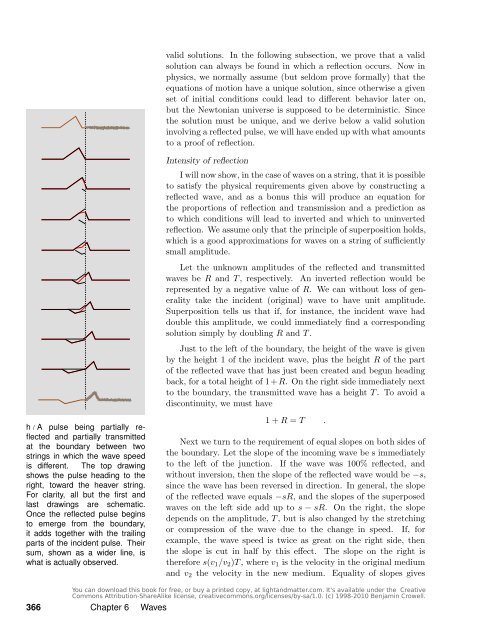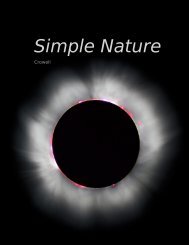The size of a radio antenna is closely related to ... - Light and Matter
The size of a radio antenna is closely related to ... - Light and Matter
The size of a radio antenna is closely related to ... - Light and Matter
You also want an ePaper? Increase the reach of your titles
YUMPU automatically turns print PDFs into web optimized ePapers that Google loves.
valid solutions. In the following subsection, we prove that a valid<br />
solution can always be found in which a reflection occurs. Now in<br />
physics, we normally assume (but seldom prove formally) that the<br />
equations <strong>of</strong> motion have a unique solution, since otherw<strong>is</strong>e a given<br />
set <strong>of</strong> initial conditions could lead <strong>to</strong> different behavior later on,<br />
but the New<strong>to</strong>nian universe <strong>is</strong> supposed <strong>to</strong> be determin<strong>is</strong>tic. Since<br />
the solution must be unique, <strong>and</strong> we derive below a valid solution<br />
involving a reflected pulse, we will have ended up with what amounts<br />
<strong>to</strong> a pro<strong>of</strong> <strong>of</strong> reflection.<br />
h / A pulse being partially reflected<br />
<strong>and</strong> partially transmitted<br />
at the boundary between two<br />
strings in which the wave speed<br />
<strong>is</strong> different. <strong>The</strong> <strong>to</strong>p drawing<br />
shows the pulse heading <strong>to</strong> the<br />
right, <strong>to</strong>ward the heaver string.<br />
For clarity, all but the first <strong>and</strong><br />
last drawings are schematic.<br />
Once the reflected pulse begins<br />
<strong>to</strong> emerge from the boundary,<br />
it adds <strong>to</strong>gether with the trailing<br />
parts <strong>of</strong> the incident pulse. <strong>The</strong>ir<br />
sum, shown as a wider line, <strong>is</strong><br />
what <strong>is</strong> actually observed.<br />
Intensity <strong>of</strong> reflection<br />
I will now show, in the case <strong>of</strong> waves on a string, that it <strong>is</strong> possible<br />
<strong>to</strong> sat<strong>is</strong>fy the physical requirements given above by constructing a<br />
reflected wave, <strong>and</strong> as a bonus th<strong>is</strong> will produce an equation for<br />
the proportions <strong>of</strong> reflection <strong>and</strong> transm<strong>is</strong>sion <strong>and</strong> a prediction as<br />
<strong>to</strong> which conditions will lead <strong>to</strong> inverted <strong>and</strong> which <strong>to</strong> uninverted<br />
reflection. We assume only that the principle <strong>of</strong> superposition holds,<br />
which <strong>is</strong> a good approximations for waves on a string <strong>of</strong> sufficiently<br />
small amplitude.<br />
Let the unknown amplitudes <strong>of</strong> the reflected <strong>and</strong> transmitted<br />
waves be R <strong>and</strong> T , respectively. An inverted reflection would be<br />
represented by a negative value <strong>of</strong> R. We can without loss <strong>of</strong> generality<br />
take the incident (original) wave <strong>to</strong> have unit amplitude.<br />
Superposition tells us that if, for instance, the incident wave had<br />
double th<strong>is</strong> amplitude, we could immediately find a corresponding<br />
solution simply by doubling R <strong>and</strong> T .<br />
Just <strong>to</strong> the left <strong>of</strong> the boundary, the height <strong>of</strong> the wave <strong>is</strong> given<br />
by the height 1 <strong>of</strong> the incident wave, plus the height R <strong>of</strong> the part<br />
<strong>of</strong> the reflected wave that has just been created <strong>and</strong> begun heading<br />
back, for a <strong>to</strong>tal height <strong>of</strong> 1+R. On the right side immediately next<br />
<strong>to</strong> the boundary, the transmitted wave has a height T . To avoid a<br />
d<strong>is</strong>continuity, we must have<br />
1 + R = T .<br />
Next we turn <strong>to</strong> the requirement <strong>of</strong> equal slopes on both sides <strong>of</strong><br />
the boundary. Let the slope <strong>of</strong> the incoming wave be s immediately<br />
<strong>to</strong> the left <strong>of</strong> the junction. If the wave was 100% reflected, <strong>and</strong><br />
without inversion, then the slope <strong>of</strong> the reflected wave would be −s,<br />
since the wave has been reversed in direction. In general, the slope<br />
<strong>of</strong> the reflected wave equals −sR, <strong>and</strong> the slopes <strong>of</strong> the superposed<br />
waves on the left side add up <strong>to</strong> s − sR. On the right, the slope<br />
depends on the amplitude, T , but <strong>is</strong> also changed by the stretching<br />
or compression <strong>of</strong> the wave due <strong>to</strong> the change in speed. If, for<br />
example, the wave speed <strong>is</strong> twice as great on the right side, then<br />
the slope <strong>is</strong> cut in half by th<strong>is</strong> effect. <strong>The</strong> slope on the right <strong>is</strong><br />
therefore s(v 1 /v 2 )T , where v 1 <strong>is</strong> the velocity in the original medium<br />
<strong>and</strong> v 2 the velocity in the new medium. Equality <strong>of</strong> slopes gives<br />
366 Chapter 6 Waves














